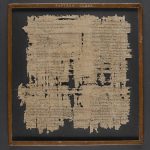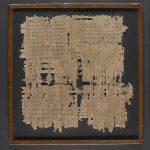| Artefact ID | 1538 |
| TM ID | TM 62310 |
| Findspot (DEChriM ID) | - () | Class | Textual |
| Material | Papyrus |
| Writing medium | Sheet/roll |
| Text content | Literary |
| Language | Greek |
| Description | P.Lond.Lit. 207, P.Lond.Lit. 255, Aland AT 51, van Haelst 109, Rahlfs 2019: Psalms and Isocrates, Ad Demonicum |
| Selection criteria | Literary genre (Biblical), Nomina sacra |
| Date from | 200 |
| Date to | 399 |
| Dating criteria | Palaeography. Barker 2007a compares the hand to P.Oxy. 51 3614 (dated to the 3rd c.). |
| Absolute/relative date | Relative date |
| Archaeological context | Unknown; acquired by the British Library in 1893 (see 1894 Catalogue of Additions). |
| Accession number | London, British Library Pap 230 |
ARTEFACT IDENTIFIERS
Editio princeps
• –––. 1894. “An Early Papyrus Fragment of the Greek Psalter.” The Athenaeum Journal of Literature, Science, the Fine Arts, Music, and the Drama, No. 2489 [Saturday, September 8, 1894]. July to December 1894: 319-321.
Additional bibliography
• –––. 1894. Catalogue of Additions to the Manuscripts in the British Museum in the Years 1888-1893. London: British Museum. 413, Pap. CCXXX.
• Aland, Kurt. 1976. Repertorium der griechischen christlichen Papyri: 1. Biblische Papyri: Altes Testament, Neues Testament, Varia, Apokryphen. Berlin/New York: De Gruyter. 117, Altes Testament (AT) 51.
• Barker, Don. 2007a. “The Nomina Sacra in P. Lond. Lit. 207.” In Proceedings of the 24th International Congress of Papyrology, Helsinki, 1-7 August, 2004. Volume I, edited by Jaakko Frösén, Tiina Purola and Erja Salmenkivi. Commentationes Humanarum Litterarum 122(1). Helsinki: Societas Scientarum Fennica. 93-100.
• Barker, Don C. 2007b. “P.Lond.Lit. 207 and the Origin of the Nomina Sacra: A Tentative Proposal.” Studia Humaniora Tartuensia 8.A.2: 1-14. [Expansion and further development]
• Carlig, Nathan. 2019. “Les rouleaux littéraires grecs composites profanes et chrétiens (début du IIIe – troisième quart du VIe siècle).” In Proceedings of the 28th Congress of Papyrology. Barcelona, 1–6 August 2016 (Pap. Congr. XXVIII), edited by Alberto Nodar and Sofía Torallas Tovar. Scripta Orientalia 3. Barcelona: Publicacions de l’Abadia de Montserrat. 366-373: 368-369, No. 3.
• Cribiore, Raffaela. 1996. Writing, Teachers, and Students in Graeco-Roman Egypt. Atlanta: Scholars Press. 245, No. 297 & 298.
• Jourdan-Hemmerdinger, Denise. 1979. “Nouveaux fragments musicaux sur papyrus (une notation antique par points).” In Studies in Eastern Chant IV, edited by Miloš Velimirovic. Crestwood (NY): St. Vladimir's Seminary Press. 81-111.
• Mandilaras, Basil G. 2003. Isocrates. Opera Omnia. Vol. I. Bibliotheca Teubneriana. Munich/Leipzig: K. G. Saur. 178, π19 [Recensio Papyrorum].
• Pruneti, Paola and Mariella Menchelli. 2008. Corpus Dei Papiri Filosofici (CPF). Testi e Lessico nei papiri di cultura greca e latina. Parte I.2: Cultura e Filosofia. Firenze: Leo S. Olschki. 934-939, 113T [21 Isocrates].
• Rahlfs, Alfred, and Detlef Fraenkel. 2004. Verzeichnis der griechischen Handschriften des Alten Testaments. Vol. 1.1: Die Überlieferung bis zum VIII. Jahrhundert. Göttingen: Vandenhoeck & Ruprecht. 215-216, Sigel 2019.
• Sarischouli, Panagiota. 1995. Berliner Griechische Papyri. Christliche Literarische Texte und Urkunden aus dem 3. bis 8. Jh. n. Chr. (Berl. Griech. Pap.). Wiesbaden: Ludwig Reichert. 49, No. 5.
• van Haelst, Joseph. 1976. Catalogue des papyrus littéraires juifs et chrétiens. Paris: Publications de la Sorbonne. 60, No. 109.


 Json data
Json data





